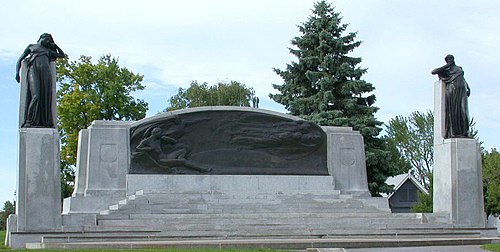Country | Canada |
| Ontario | |
| Brant (independent) |
• Land | 72.47 km2 (27.98 sq mi) |
• Metro | 1,073.11 km2 (414.33 sq mi) |
Elevation | 248 m (814 ft) |
| 93,650 (54th) | |
• Density | 1,292.3/km2 (3,347/sq mi) |
• Metro | 135,501 (30th) |
• Metro density | 126.3/km2 (327/sq mi) |
| Eastern (EST) (UTC−5) | |
• Summer (DST) | EDT (UTC−4) |
Postal code span | N3P, N3R, N3S, N3T, N3V |
| 519/226 | |

 The Bell Telephone Memorial, commemorating the invention of the telephone by Alexander Graham Bell. The monument, paid by public subscription and sculpted by W.S. Allward, was dedicated by the Governor General of Canada, Victor Cavendish, 9th Duke of Devonshire with Dr. Bell in The Telephone City's Alexander Graham Bell Gardens in 1917. Included on the main tableau are figures representing "Man, the Inventor," "Inspiration whispering to Man, his power to transmit sound through space," as well as "Knowledge, Joy, Sorrow." Courtesy: Brantford Heritage Inventory
The Bell Telephone Memorial, commemorating the invention of the telephone by Alexander Graham Bell. The monument, paid by public subscription and sculpted by W.S. Allward, was dedicated by the Governor General of Canada, Victor Cavendish, 9th Duke of Devonshire with Dr. Bell in The Telephone City's Alexander Graham Bell Gardens in 1917. Included on the main tableau are figures representing "Man, the Inventor," "Inspiration whispering to Man, his power to transmit sound through space," as well as "Knowledge, Joy, Sorrow." Courtesy: Brantford Heritage Inventory| [show]Climate data for Brantford (1981−2010) |
| Historical population | ||
| Year | Pop. | ±% |
1841 | 2,000 | — |
1871 | 8,107 | +305.3% |
1881 | 9,616 | +18.6% |
1891 | 12,753 | +32.6% |
1901 | 16,619 | +30.3% |
23,132 | +39.2% | |
1921 | 29,440 | +27.3% |
1931 | 30,107 | +2.3% |
1941 | 31,622 | +5.0% |
1951 | 36,727 | +16.1% |
1961 | 55,201 | +50.3% |
1971 | 64,421 | +16.7% |
1981 | 74,315 | +15.4% |
1991 | 81,997 | +10.3% |
84,764 | +3.4% | |
86,417 | +2.0% | |
90,192 | +4.4% | |
93,650 | +3.8% | |
| Visible minority and Aboriginal population (Canada 2011 Census) | |||
| Population group | Population | % of total population | |
| White | 81,035 | 88.1% | |
| Visible minority group Source:[14] | South Asian | 1,640 | 1.8% |
| Chinese | 710 | 0.8% | |
| Black | 1,550 | 1.7% | |
| Filipino | 450 | 0.5% | |
| Latin American | 365 | 0.4% | |
| Arab | 575 | 0.6% | |
| Southeast Asian | 740 | 0.8% | |
| West Asian | 80 | 0.1% | |
| Korean | 285 | 0.3% | |
| Japanese | 95 | 0.1% | |
| Visible minority, n.i.e. | 100 | 0.1% | |
| Multiple visible minority | 255 | 0.3% | |
| Total visible minority population | 6,850 | 7.4% | |
| Aboriginal group Source:[15] | First Nations | 3,565 | 3.9% |
| Métis | 355 | 0.4% | |
| Inuit | 0 | 0% | |
| Aboriginal, n.i.e. | 95 | 0.1% | |
| Multiple Aboriginal identity | 55 | 0.1% | |
| Total Aboriginal population | 4,090 | 4.4% | |
| Total population in private households | 91,975 | 100% | |
 Brantford campus of Nipissing University
Brantford campus of Nipissing University Brantford City Hall
Brantford City Hall Highway 403 connects Brantford with Woodstock and Hamilton. Seen here is the 403 eastbound near the Grand River bridge.
Highway 403 connects Brantford with Woodstock and Hamilton. Seen here is the 403 eastbound near the Grand River bridge. The Armoury
The Armoury The main entrance to the Brantford Public Library
The main entrance to the Brantford Public Library| 欢迎光临 枫下之音 - 加拿大留学移民生活网Brantford华人论坛 (http://www.maplevoice.com/bbs/) | Powered by Discuz! X3.1 |